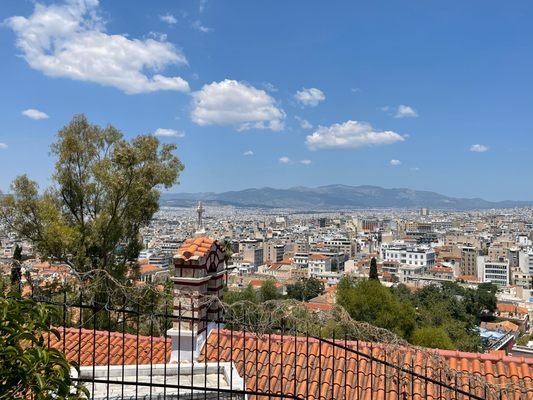About
In 1840, experienced builders from the island of Anafi traveled to Athens to work construction jobs on the new Royal Palace and excavation sites around the Acropolis. Taking advantage of a new law, these builders hastily built houses on the steep northern hillside of the Acropolis and permanently relocated. They called their settlement Anafiotika, (“Little Anafi”), after their island.
In 1847, the residents identified a location on the northwestern side of their settlement to build a church. The location was originally the site of a 17th-century basilica, renovated in 1774, and severely damaged during the War of Independence. The residents rebuilt the church as a single-aisled basilica, with blind arches on the long walls and other transverse reinforcements.
The roof was terra cotta, with the bell tower being painted with terra cotta stripes in a German style. A large terrace was built on the western side, with two small Anafi-style outbuildings in the courtyard. The church had a frescoed interior, with numerous detailed icons, including one of the Virgin Mary Kalamiotissa that can still be seen in the church today.
The church was dedicated to St, Symeon the New Theologian, a Byzantine Christian monk and poet who was the last of three saints canonized by the Eastern Orthodox church. St. Symeon the New Theologian was born into a wealthy family in Anatolia in 949. He was educated as a youth in Constantinople, and at age 14 he met the renowned Elder Saint Symeon the Studite at the Studion Monastery.
St. Symeon the Studite became an early influence on the young Symeon and assisted him in preparing himself for monastic life. St. Symeon the new Theologian entered monastic life at age 27. He soon became the Abbot of the Monastery of Saint Mamas, a position he held for 25 years.
Upon the completion of the church, a priest relocated from Anafi and the church started serving parishioners and continues to do so to this day. The church still has strong ties to Anafi, having membership in the Association of Anafaia Everywhere.
Related Tags
Know Before You Go
The church holds liturgy each Sunday. The church celebrates the annual feast for Saint Symeon on February 3. Dress codes vary from church to church in Greek Orthodoxy. If you wish to enter the church, wear modest clothing and be respectful. For men shorts, tank tops/sleeveless shirts, and sandals/flip flops are frowned upon.
Women's shoulders should not be shown in church, so anything strapless or with thin straps should be avoided. Skirts and dresses should at a minimum come below the knee. Some churches ask that no leg be shown. Feet should be kept on the ground when seated as it is considered insulting for the bottoms of feet to face holy images.
Community Contributors
Added By
Published
March 4, 2024











































